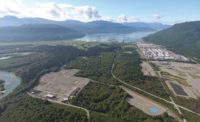Keeyask is one of three major hydropower projects under construction in Canada—a country that gets 59% of its electricity from hydropower. Judging by the problems faced at all three sites, they could be the last three built in the country for decades.
The most problematic of the hydro plants is Nalcor Energy’s Muskrat Falls. On Oct. 18, it ordered contractor Astaldi Canada to stop work on the project because of its “inability to pay its workers” after its Italian-based parent company filed for bankruptcy earlier this month.
As of Oct. 22, all but 25 of Astaldi’s 500 workers on the job had been sent home, and Nalcor, a crown corporation—meaning it is owned by the state—said it was working on a contingency plan to complete the 5% of work remaining on the powerhouse, intake and spillway, according to Nalcor spokeswoman Karen O’Neil. “The remaining work is not on the critical path and therefore won’t hold us up for achieving first power next year as planned,” she says.
Astaldi did not respond to a request for comment. SNC-Lavalin, the engineering, procurement and construction management contractor for the 824-MW plant job, referred all questions to Nalcor. The project, located on the Churchill River in Labrador, is the second hydro facility in what is considered the Lower Churchill complex. A separate joint venture of Barnard-Pennecon is building the north and south dams at the facility.
|
Related Article |
The Astaldi problems at Muskrat Falls come on top of a year-long formal inquiry into the Muskrat project, which has doubled in price to almost CA$13 billion ($9.9 billion) and could be a burden and boondoggle to the province’s population of 530,000 if the power isn’t sold elsewhere.
Cost overruns are a worldwide problem with hydro projects, according to a report completed for the Muskrat Falls inquiry by Bent Flyvbjerg, an Oxford University professor who studies megaprojects. Flyvbjerg notes that hydro projects, on average, have cost overruns of 96% and schedule overruns of 42%. “The cost and schedule risks of dams is only exceeded by nuclear power projects,” the report states. “Often cost and schedule overruns are explained by unforeseen conditions and adverse events, e.g., unforeseen geology, project complexity, scope changes, bad weather. However, these are not root causes. The root causes … can be found in optimism and political bias in estimates of geology, complexity, scope, weather, etc., which translate into underestimates of cost and schedule, which later turn into cost and schedule overruns.”
Muskrat Falls, and a third Canadian hydro project under construction—BC Hydro’s Site C in the Peace River Valley of British Columbia, are opposed by indigenous people and others because of their environmental impact. Muskrat Falls is opposed, among other reasons, because of the potential methylmercury poisoning that could occur downstream. Site C faces resistance because the reservoir will flood 100 sq km of land that is still occupied and farmed by First Nations people who live in the Peace River Valley.
Still, the three crown corporations that have implemented the projects have the same rationale: “Once complete … the project will provide clean, reliable and cost-effective electricity for more than 100 years,” says BC Hydro of its 1,100-MW, Site C dam. New provincial leadership threatened to cancel the project, which has grown in cost by CA$2 billion ($1.5 billion) to CA$10.7 billion ($8.2 billion). But the new government decided that the project, which began in 2015, was too far along to cancel. ACCIONA, Petrowest and Samsung are the main civil works contractors for the project, which is expected to be complete in 2024.






Post a comment to this article
Report Abusive Comment